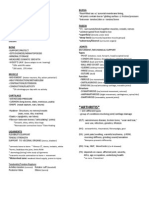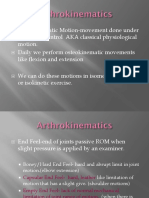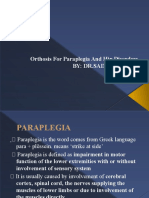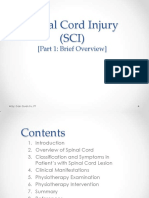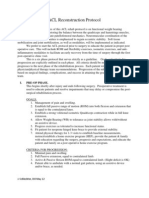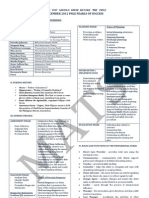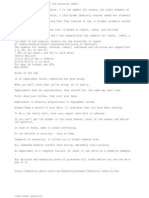Scoliosis
Scoliosis
Uploaded by
Dharline Abbygale Garvida AgullanaCopyright:
Available Formats
Scoliosis
Scoliosis
Uploaded by
Dharline Abbygale Garvida AgullanaCopyright
Available Formats
Share this document
Did you find this document useful?
Is this content inappropriate?
Copyright:
Available Formats
Scoliosis
Scoliosis
Uploaded by
Dharline Abbygale Garvida AgullanaCopyright:
Available Formats
Scoliosis
NORMAL SPINE
CURVE PATTERNS
A normal spine, when viewed from behind, appears straight. However, a spine affected by scoliosis shows evidence of a lateral, or side-by-side curvature, with the spine looking like an "S" or "C" and a rotation of the back bones (vertebrae), giving the appearance that the person is leaning to one side. Thus, the name scoliosis is derived from the Ancient Greek word skolios meaning crooked. The Scoliosis Research Society defines scoliosis as a curvature of the spine measuring 10 degrees or greater. Scoliosis is a type of spinal deformity and should not be confused with poor posture. Spinal curvature from scoliosis may occur on the right or left side of the spine, or on both sides in different sections. Both the thoracic (mid) and lumbar (lower) spine may be affected by scoliosis. Incidence Scoliosis is about two times more common in girls than boys. It can be seen at any age, but it is most common in those over 10 years of age. Scoliosis is hereditary in that people with scoliosis are more likely to have children with scoliosis; however, there is no correlation between the severities of the curve from one generation to the next. In over 80 percent of cases, the cause of scoliosis is unknown a condition called idiopathic scoliosis. Pathophysiology of Scoliosis Scoliosis is an abnormal sideways curvature of the spine that is typically found in children and adolescents. In most cases, scoliosis is painless. However, it can become gradually more severe if left untreated, resulting in chronic back pain. In young children, severe cases can cause deformities, impair development and be life-threatening.
In most cases, scoliosis is painless and develops gradually. It often worsens during growth spurts in children and teens. Scoliosis patients who wear a back brace over an extended period of time can usually prevent further curvature of the spine. The cause of most cases of scoliosis cases is unknown (idiopathic). Suspected causes of scoliosis include connective tissue disorders, muscle disorders, hormonal imbalance and abnormality of the nervous system. Spinal cord and brainstem abnormalities may also contribute to scoliosis. The condition can also be hereditary. Physicians classify the causes of scoliosis curves into one of two categories: Nonstructural scoliosis. Also known as functional scoliosis, this involves a spine that is structurally normal yet appears curved. This is a temporary curve that changes, and is caused by an underlying condition such as difference in leg length, muscle spasms or inflammatory conditions such as appendicitis. Physicians usually treat this type of scoliosis by addressing the underlying condition. The term nonstructural scoliosis has also been used to describe cases involving a side to side curvature. Structural scoliosis. This is a fixed curve that is treated individually according to its cause. Some cases of structural scoliosis are the result of disease, such as the inherited connective tissue disorder known as Marfan s syndrome. In other cases, the curve occurs on its own. Other causes include neuromuscular diseases (such as cerebral palsy, poliomyelitis or muscular dystrophy), birth defects, injury, infection, tumors, metabolic diseases, rheumatic diseases or unknown factors. The term structural scoliosis has also been used to describe cases involving a twisting of the spine in three dimensions rather than a sideways curvature. Certain factors are known to increase the risk for scoliosis, as well as the risk that the disorder will become more severe. These include: Sex. Girls ages 3 and older are more likely to have scoliosis than boys. In contrast, boys are more likely to have the disorder than girls before age 3. Age. The younger a child is when scoliosis begins, the more severe the condition is likely to become. Angle of the curve. The greater that angle of curve, the increased likelihood that the condition will get worse. Location. Curves in the middle to lower spine are less likely to worsen than those of the upper spine. Spinal problems at birth. Children who are born with scoliosis (congenital scoliosis) may experience rapid worsening of the curve. Three Types of Scoliosis Congenital. This type of scoliosis occurs during fetal development. It is often caused by one of the following: o Failure of the vertebrae to form normally o Absence of vertebrae o Partially formed vertebrae o Lack of separation of the vertebrae Neuromuscular. This type of scoliosis is associated with many neurological conditions,
especially in those children who do not walk, such as the following: o Cerebral palsy o Spina bifida o Muscular dystrophy o Paralytic conditions o Spinal cord tumors o Neurofibromatosis (This is a genetic condition that affects the peripheral nerves that causes changes to occur in the skin, called caf-au-lait spots.) Idiopathic. The cause of this type of scoliosis is unknown. There are three types of idiopathic scoliosis: o Infantile (This type of scoliosis occurs from birth to age 3. The curve of the vertebrae is to the left and it is more commonly seen in boys. Typically, the curve resolves as the child grows.) o Juvenile (Juvenile scoliosis occurs in children between ages 3 and 10.) o Adolescent (This type of scoliosis occurs in children between ages 10 and 18. This is the most common type of scoliosis and is more commonly seen in girls.) Diagnosis for Scoliosis In addition to a complete medical history and physical examination, X-rays (a diagnostic test which uses invisible electromagnetic energy beams to produce images of internal tissues, bones, and organs onto film) are the primary diagnostic tool for scoliosis. In establishing a diagnosis of scoliosis, the physician measures the degree of spinal curvature on the X-ray. The following other diagnostic procedures may be performed for nonidiopathic curvatures, atypical curve patterns, or congenital scoliosis: Magnetic resonance imaging (MRI). This diagnostic procedure uses a combination of large magnets and a computer to produce detailed images of organs and structures within the body. Computed tomography (CT) scan. This diagnostic imaging procedure uses a combination of X-rays and computer technology to produce cross-sectional images (often called slices), both horizontally and vertically, of the body. A CT scan shows detailed images of any part of the body, including the bones, muscles, fat, and organs. CT scans are more detailed than general X-rays. Early detection of scoliosis is most important for successful treatment. Pediatricians or family physicians, and even some school programs, routinely look for signs that scoliosis may be present. Treatment for scoliosis The goal of treatment is to stop the progression of the curve and prevent deformity. Treatment may include: Observation and repeated examinations. Observation and repeated examinations may be necessary to determine if the spine is continuing to curve, and are used when a person has a curve of less than 25 degrees and is still growing. Progression of the curve depends upon the amount of skeletal growth, or the skeletal maturity of the child. Curve progression slows down or stops after the child reaches puberty. Bracing. Bracing may be used when the curve measures more than 25 to 30 degrees on an X-ray, but skeletal growth remains. It may also be necessary if a person is growing and has a curve between 20 and 29 degrees that isn't improving. The type of brace and the amount
of time spent in the brace will depend on your child's condition. Surgery. Surgery may be recommended when the curve measures 45 degrees or more on an X-ray and bracing isn't successful in slowing down the progression of the curve when a person is still growing. According to the National Institute of Arthritis and Musculoskeletal and Skin Disorders, there is no scientific evidence to show that other methods for treating scoliosis (for example, chiropractic manipulation, electrical stimulation, nutritional supplementation, and exercise) prevent the progression of the disease. If left untreated, scoliosis can cause problems with heart and lung function. Main Duties and Responsibilities Act as principal liaison for the effective admission planning and eventual discharge of children with spinal disorders including trauma and adult patients with spinal deformity. Develop and implement care pathways regarding pre operative preparation and management of inpatients. Provide written and verbal advice for patients/families. Run nurse-led clinics for children and adult patients with scoliosis in conjunction with nominated consultants. Participate in out-patients consultations. Provide specialist education and training for ward/dept nurses, other health professionals and students within the NUH. Providing Telephone advice service for patients/families and ward/dept nurses. Undertake/participate in clinical audit in the field of scoliosis.
You might also like
- Blueprints in Neurology 5th Edition 2019Document536 pagesBlueprints in Neurology 5th Edition 2019Ciobotaru Delia100% (10)
- MedSurg Notes - Nurse's Clinical Pocket Guide (FA Davis, 2007)Document242 pagesMedSurg Notes - Nurse's Clinical Pocket Guide (FA Davis, 2007)Keron Hou97% (69)
- Dns PDFDocument22 pagesDns PDFOtrovanje100% (1)
- Nursing PharmacologyDocument22 pagesNursing PharmacologyDharren Rojan Garvida Agullana100% (2)
- Head Nursing Evaluation ToolDocument2 pagesHead Nursing Evaluation ToolDharline Abbygale Garvida Agullana100% (6)
- Physiotherapy For Tennis ElbowDocument2 pagesPhysiotherapy For Tennis ElbowenadNo ratings yet
- Total Knee ReplacementDocument99 pagesTotal Knee ReplacementGandis Ayu WardaniNo ratings yet
- Frozen Shoulder - Adhesive Capsulitis - OrthoInfo - AAOSDocument6 pagesFrozen Shoulder - Adhesive Capsulitis - OrthoInfo - AAOSpempekplgNo ratings yet
- Orthopedic DisordersDocument9 pagesOrthopedic DisordersDanielle_Liedt_563No ratings yet
- Joint Mobilization Techniques For Sacroiliac Joint DysfunctionDocument17 pagesJoint Mobilization Techniques For Sacroiliac Joint Dysfunctiongaby_spy100% (3)
- Moore (2000) A Review of Eeg Biofeedback Treatment of AnxietyDocument6 pagesMoore (2000) A Review of Eeg Biofeedback Treatment of AnxietyAnonymous ovTI4eNo ratings yet
- Scoliosis: Spinal Curvature, KyphoscoliosisDocument3 pagesScoliosis: Spinal Curvature, Kyphoscoliosisiamweena17No ratings yet
- ScoliosisDocument18 pagesScoliosisMj EnofnaNo ratings yet
- Forearm Fractures, A Simple Guide To The Condition, Diagnosis, Treatment And Related ConditionsFrom EverandForearm Fractures, A Simple Guide To The Condition, Diagnosis, Treatment And Related ConditionsNo ratings yet
- Avascular Necrosis, A Simple Guide To The Condition, Diagnosis, Treatment And Related ConditionsFrom EverandAvascular Necrosis, A Simple Guide To The Condition, Diagnosis, Treatment And Related ConditionsRating: 4 out of 5 stars4/5 (2)
- The Thoracic Outlet Syndrome, A Simple Guide To The Condition, Diagnosis, Treatment And Related ConditionsFrom EverandThe Thoracic Outlet Syndrome, A Simple Guide To The Condition, Diagnosis, Treatment And Related ConditionsNo ratings yet
- Cauda Equina Syndrome: A Beginner's Overview to Managing CES Through Natural Methods and Diet, With Sample Recipes Kindle EditionFrom EverandCauda Equina Syndrome: A Beginner's Overview to Managing CES Through Natural Methods and Diet, With Sample Recipes Kindle EditionNo ratings yet
- Scoliosis: Degenerative & IdiopathicDocument34 pagesScoliosis: Degenerative & IdiopathicClaudia MariscaNo ratings yet
- Acromioclavicular Joint Injuries and Physical Therapy ManagementDocument12 pagesAcromioclavicular Joint Injuries and Physical Therapy ManagementSereinNo ratings yet
- Assignment: Cervical SpondylosisDocument14 pagesAssignment: Cervical SpondylosisJaspreet kaurNo ratings yet
- Kyphosis - Lecture 2013Document70 pagesKyphosis - Lecture 2013Dibyendunarayan BidNo ratings yet
- Extensor Tendon InjuriesDocument18 pagesExtensor Tendon InjuriesaparnaNo ratings yet
- ACL Reconstruction Rehabilitation GuidelinesDocument4 pagesACL Reconstruction Rehabilitation Guidelinesfia0711No ratings yet
- Topic:-Posture: Dr:Maryam Memon Lecturer: JmiprsDocument43 pagesTopic:-Posture: Dr:Maryam Memon Lecturer: JmiprsAazeen memonNo ratings yet
- Sprengel's ShoulderDocument21 pagesSprengel's ShoulderNahayo Xavier100% (1)
- Disability Evaluation: Radhika ChintamaniDocument58 pagesDisability Evaluation: Radhika ChintamaniBhavya Amin0% (1)
- Posterior Cruciate Ligament (PCLR) Rehabilitation ProtocolDocument19 pagesPosterior Cruciate Ligament (PCLR) Rehabilitation ProtocolosamadrNo ratings yet
- Screening The Sacrum, Sacroiliac, and PelvisDocument31 pagesScreening The Sacrum, Sacroiliac, and PelvisMajgsjqNo ratings yet
- Anterior Cruciate Ligament Surgery: Trauma & Orthopaedic DirectorateDocument38 pagesAnterior Cruciate Ligament Surgery: Trauma & Orthopaedic DirectorateSzilvia MartonosNo ratings yet
- HydrotherapyDocument21 pagesHydrotherapy7e9oo90% (1)
- Upper Limb OrthosesDocument29 pagesUpper Limb OrthosesMaryam KhalidNo ratings yet
- CH 4 ArthrokinematicsDocument17 pagesCH 4 ArthrokinematicsBoddu Suresh BabuNo ratings yet
- Managment of ScoliosisDocument18 pagesManagment of ScoliosisCarlos Fernando Roca AkamineNo ratings yet
- Erbs PalsyDocument9 pagesErbs PalsyVatsalVermaNo ratings yet
- Scoliosis: Aka: Idiopathic Scoliosis, Adolescent ScoliosisDocument12 pagesScoliosis: Aka: Idiopathic Scoliosis, Adolescent ScoliosisLei Coloma SissonNo ratings yet
- CTEVDocument27 pagesCTEVJevisco LauNo ratings yet
- 2017 Spine ExaminationDocument7 pages2017 Spine Examinationradhika thapaNo ratings yet
- Introduction PhysiotherapistDocument12 pagesIntroduction Physiotherapistapi-371068989No ratings yet
- Examination of ElbowDocument18 pagesExamination of Elbowharmohit singhNo ratings yet
- Arthrogryposis Multiplex Congenita-Dr S P DasDocument7 pagesArthrogryposis Multiplex Congenita-Dr S P DasSheel GuptaNo ratings yet
- Hip DisorderDocument45 pagesHip DisorderMaryam KhalidNo ratings yet
- Legg Calve Perthes Disease: SynonymsDocument35 pagesLegg Calve Perthes Disease: SynonymsAsad ChaudharyNo ratings yet
- Klumpke's ParalysisDocument7 pagesKlumpke's ParalysisNeelam VermaNo ratings yet
- Lower Limb Fracture..MeDocument142 pagesLower Limb Fracture..MeWorku KifleNo ratings yet
- Screening The Sacrum, Sacroiliac, and PelvisDocument35 pagesScreening The Sacrum, Sacroiliac, and PelvisWalijaNo ratings yet
- ACL Injuries: Care of The Young Athlete Patient Education HandoutsDocument2 pagesACL Injuries: Care of The Young Athlete Patient Education Handoutsindra20dhira100% (1)
- Ankylosing SpondylitisDocument19 pagesAnkylosing SpondylitisZulhida YuniNo ratings yet
- Knee Biomechanics: Mark Arthur Martinez Trauma 1 April 5, 2018Document7 pagesKnee Biomechanics: Mark Arthur Martinez Trauma 1 April 5, 2018Juan Alvaro EstradaNo ratings yet
- Volkmann's Ischemic Contracture by Innocent C. AbuguDocument38 pagesVolkmann's Ischemic Contracture by Innocent C. AbuguChukwuemeka ChidogoNo ratings yet
- ICUDocument12 pagesICUNabilahNo ratings yet
- Physiotherapy Assessment and Treatment On PICUDocument54 pagesPhysiotherapy Assessment and Treatment On PICUBatool Rehman100% (3)
- Orthopaedic PhysiotherapyDocument6 pagesOrthopaedic PhysiotherapyAhmedElhamyNo ratings yet
- 25 Congenital Scoliosis (Dr. Fazl Karam)Document45 pages25 Congenital Scoliosis (Dr. Fazl Karam)Dev ZunigaNo ratings yet
- Spinal Cord InjuryDocument39 pagesSpinal Cord InjuryrahatNo ratings yet
- Prescription Principle of KAFODocument54 pagesPrescription Principle of KAFOFERYANDA UTAMI100% (1)
- Lumbar Disc HerniationDocument8 pagesLumbar Disc Herniationandra_scooterNo ratings yet
- Physical Therapy Management of Congenital Muscular.2Document47 pagesPhysical Therapy Management of Congenital Muscular.2Physio EbookNo ratings yet
- ICF-Ankle Trimalleolar FractureDocument18 pagesICF-Ankle Trimalleolar FracturedvenumohanNo ratings yet
- Mat ActivitiesDocument2 pagesMat ActivitiesAtul SrivastavaNo ratings yet
- Therapeutic Exercise (I) : Theory and PracticeDocument155 pagesTherapeutic Exercise (I) : Theory and PracticeAbdulrhman MohamedNo ratings yet
- Joint MobilizationDocument42 pagesJoint MobilizationSérgio Xavier Silva100% (1)
- Physiotherapy Management ForDocument28 pagesPhysiotherapy Management Formayuri zanwarNo ratings yet
- Cervical PainDocument4 pagesCervical PainRhomadhoni Ika PutraNo ratings yet
- GaitDocument42 pagesGaitTan Geok EngNo ratings yet
- Acl Reconstruction ProtocolDocument8 pagesAcl Reconstruction ProtocolMestereaga AlinNo ratings yet
- Coxa Vara and Coxa ValgaDocument34 pagesCoxa Vara and Coxa ValgaAnagha kNo ratings yet
- Without Advance Notice To The BorrowerDocument2 pagesWithout Advance Notice To The BorrowerDharline Abbygale Garvida AgullanaNo ratings yet
- CHN&CDDocument7 pagesCHN&CDDharline Abbygale Garvida AgullanaNo ratings yet
- Pemphigus VulgarisDocument1 pagePemphigus VulgarisDharline Abbygale Garvida AgullanaNo ratings yet
- Business Proposal Ilocos NorteDocument4 pagesBusiness Proposal Ilocos NorteDharline Abbygale Garvida AgullanaNo ratings yet
- CHN&CDDocument7 pagesCHN&CDDharline Abbygale Garvida AgullanaNo ratings yet
- December2012nletips Funda 121005040112 Phpapp02 PDFDocument6 pagesDecember2012nletips Funda 121005040112 Phpapp02 PDFJessamine Rochelle Reyes EsbertoNo ratings yet
- Oncologic NursingDocument16 pagesOncologic NursingDharline Abbygale Garvida AgullanaNo ratings yet
- Mitosis ActivityDocument2 pagesMitosis ActivityDharline Abbygale Garvida AgullanaNo ratings yet
- At PreboardDocument12 pagesAt PreboardKevin Ryan EscobarNo ratings yet
- Planning and Organizing LecturesDocument3 pagesPlanning and Organizing LecturesDharline Abbygale Garvida AgullanaNo ratings yet
- NCPDocument3 pagesNCPDharline Abbygale Garvida Agullana100% (2)
- Grandparent 2Document20 pagesGrandparent 2Dharline Abbygale Garvida AgullanaNo ratings yet
- Chemistry JokesDocument3 pagesChemistry JokesDharline Abbygale Garvida AgullanaNo ratings yet
- Cocaine Addiction Severity TestDocument4 pagesCocaine Addiction Severity TestDharline Abbygale Garvida AgullanaNo ratings yet
- Industry BackgroundDocument1 pageIndustry BackgroundDharline Abbygale Garvida AgullanaNo ratings yet
- KorsakoffDocument4 pagesKorsakoffDharline Abbygale Garvida AgullanaNo ratings yet
- Myocardial InfarctionDocument5 pagesMyocardial InfarctionDharline Abbygale Garvida AgullanaNo ratings yet
- Predisposing/ Non-Modifialbe Precipitating/ Modifiable: HepaticDocument2 pagesPredisposing/ Non-Modifialbe Precipitating/ Modifiable: HepaticDharline Abbygale Garvida AgullanaNo ratings yet
- Meat Processing IndustryDocument36 pagesMeat Processing IndustryDharline Abbygale Garvida Agullana100% (1)
- Tourette SyndromeDocument3 pagesTourette SyndromeJhon Stephen Rimando CatalanNo ratings yet
- Better Habits, Better You - Form New Habits and Make Them StickDocument14 pagesBetter Habits, Better You - Form New Habits and Make Them StickRazak KONINo ratings yet
- Chapter 2 Basic ExercisesDocument8 pagesChapter 2 Basic ExercisesAnh Thu TranNo ratings yet
- Sensory: Sensory Ecology Is The Study of How Organisms Acquire, Process, and Respond To InformationDocument10 pagesSensory: Sensory Ecology Is The Study of How Organisms Acquire, Process, and Respond To InformationAlthea0% (1)
- Prelim HPCTDocument37 pagesPrelim HPCTMariaangela AliscuanoNo ratings yet
- Introduction To EducationDocument76 pagesIntroduction To EducationHina Kaynat100% (1)
- Shoemaker and Inner Sense-LormandDocument35 pagesShoemaker and Inner Sense-LormandwalterhornNo ratings yet
- WARWICK, KEVIN - Controlling A Mobile Robot With A Biological BrainDocument11 pagesWARWICK, KEVIN - Controlling A Mobile Robot With A Biological BrainGastón G. FernándezNo ratings yet
- Neurology 5Document5 pagesNeurology 5Loyla RoseNo ratings yet
- Camillo Negro and His Contributions To NeurologyDocument3 pagesCamillo Negro and His Contributions To NeurologyPsikiatri 76 UndipNo ratings yet
- Unilateral Neglect: Assessment and Rehabilitation: Richard P. Conti, Jacqueline M. ArnoneDocument10 pagesUnilateral Neglect: Assessment and Rehabilitation: Richard P. Conti, Jacqueline M. Arnonejerrin jacobNo ratings yet
- 30.bobath Tech 1Document13 pages30.bobath Tech 1Zeeshan AhmadNo ratings yet
- Mod 2Document30 pagesMod 2mailtopiyush18No ratings yet
- 7 Best Acupressure Points For Better Eye Sight - Improve Your VisionDocument13 pages7 Best Acupressure Points For Better Eye Sight - Improve Your VisionSacha Myc100% (1)
- NeuroMuscular Blocking AgentsDocument3 pagesNeuroMuscular Blocking AgentsdrugdrugNo ratings yet
- Medical Detectives NotebookDocument118 pagesMedical Detectives NotebookagraceNo ratings yet
- Mental Health and Psychiatric NursingDocument14 pagesMental Health and Psychiatric NursingJAY-AR DAITNo ratings yet
- Central Nervous System Grade 5Document21 pagesCentral Nervous System Grade 5shamshadNo ratings yet
- Effectiveness of Coma Stimulation Therapy On Traumatic Brain InjurypatientsDocument5 pagesEffectiveness of Coma Stimulation Therapy On Traumatic Brain InjurypatientsZoroNo ratings yet
- Effects of Drugs On Synaptic ActivityDocument3 pagesEffects of Drugs On Synaptic ActivityAkhwand SaulatNo ratings yet
- Cannabis PsychosisDocument7 pagesCannabis PsychosisBikash AhmedNo ratings yet
- SquintDocument36 pagesSquintbismahNo ratings yet
- Don't Sweat The Small ThingsDocument3 pagesDon't Sweat The Small ThingsJiseuleinNo ratings yet
- Module 4, Assignment 1 - Assessing Infants and ToddlersDocument2 pagesModule 4, Assignment 1 - Assessing Infants and ToddlersMichael MerlinNo ratings yet
- 2022 Benzels Spine Surgery 5th Ed Vol1 (1) - Copy - ComprimidoDocument5 pages2022 Benzels Spine Surgery 5th Ed Vol1 (1) - Copy - ComprimidoJavier Fernando Cabezas MeloNo ratings yet
- NCP Visual SensoryDocument2 pagesNCP Visual SensoryEugene UCNo ratings yet
- Mental Health DisordersDocument7 pagesMental Health DisorderskgjtertijNo ratings yet








